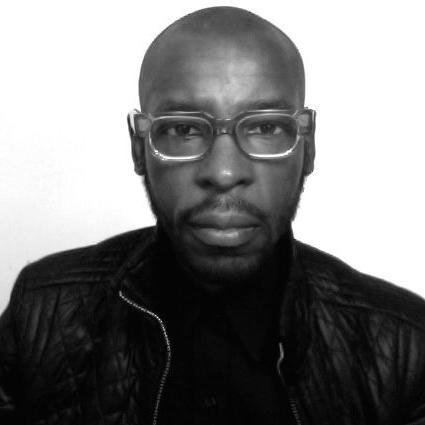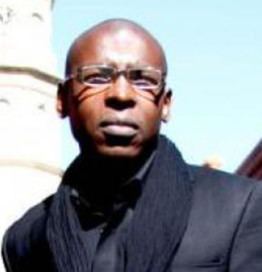Name Mario Gooden | ||
 | ||
Why Does Black Art Matter Now: Speculative Design Propositions
Mario Gooden (Born 1965) is a principal and founder of Huff + Gooden Architects. Gooden co-founded Huff + Gooden with his partner Ray Huff in 1997. Gooden is also a Professor of Practice at the Graduate School of Architecture, Planning and Preservation (GSAPP) of Columbia University, where he teaches architectural design and theory. Gooden held previous academic appointments at the Yale School of Architecture as the Louis I. Khan Distinguished Visiting Professor, the Southern California Institute of Architecture (Sci-Arc) in Los Angeles, the University of Arizona (Tucson), the University of Florida (Gainesville), Clemson University, and The City College of New York.
Contents
- Why Does Black Art Matter Now Speculative Design Propositions
- Biography
- Architectural Work
- Research
- Writing
- Buildings and Projects
- References

Biography
In 1987 Gooden received his Bachelor of Science in Design from Clemson University, (Magna cum Laude). In 1990 he received a Master of Architecture degree from the Columbia University Graduate School of Architecture, Planning and Preservation, New York, and was the recipient of the Charles McKim Prize for Excellence in Design.
Gooden’s firm’s work has been featured in journals and publications including Architecture Magazine, Architectural Record Magazine, Metropolis, The New York Times, Architecture & Urbanism (A+U) and ARTFORUM International Magazine. Huff + Gooden Architects work has been exhibited at the 11th Venice Biennale in 2006, the Netherlands Architecture Institute (NAi), the National Building Museum in Washington, DC, and the Municipal Arts Society in New York. Gooden previously worked in the offices of Zaha Hadid in London and Steven Holl in New York.
Gooden’s work, writings, and lectures frequently examine architecture and the translation of cultural landscapes defined by the parameters of race, class, gender, and technology. His urban and cultural theory research was published at the Dubai Initiative’s Urbanism in the Middle East: A Search for New Paradigms in 2011 and Layered Urbanisms (Yale University, 2008). He is the editor of Global Topologies: Converging Territories (Columbia University, 2013).
Architectural Work
Visual and performance / performing art are particular lenses through which Gooden seeks new pedagogical strategies between art, architecture, and culture in order to articulate new sites of meanings in his practice.
In 2011, Huff + Gooden Architects, was selected to design the $67million renovation and expansion to the California African American Museum located in Exposition Park in Los Angeles, California. The design is a cultural critique of the current museum’s physical and cultural context and the expanded museum’s social visibility.
In 2005 Gooden and Huff curated and designed the installation, entitled Un/Spoken Spaces: Inside and Outside the Boundaries of Class Race and Space at the Gibbes Museum of Art in Clemson, South Carolina. The exhibition was curated from works in the museum’s permanent collection, which consists primarily 19th century portraiture and southern plantation scenes to reveal how the collection and architecture have been used to spatialize and reinforce issues of class and race.
Huff + Gooden’s 2005 international competition winning design for the Virginia Key Beach Park Museum in Miami, Florida is included in the American architectural history textbook, USA: Modern Architectures in History (Reaktion Books, 2008) by Gwendolyn Wright. In chapter seven, “Disjunctures and Alternatives, 1985 to the Present” Wright states:
"Significant architecture helps us confront contentious topics. Huff + Gooden, an African-American firm based in Charleston, South Carolina, have designed a small museum for the Virginia Key Beach Park (2005–8) that underscores the ambiguities of racial pride and segregation…. The structure and the larger landscape by Walter Hood continue the theme of multiplicities and changes overtime…This new sensibility in American modern architecture encourages visitors to contemplate multiple dimensions of the past and the future, buildings and their surroundings."
Research
Gooden’s research formulated in his design studio teaching and through the Global Africa Lab (GAL) at Columbia University, focuses on the development of scripting tools and parametric software. Developed along with Adjunct Assistant Professor Carson Smuts, the parametric software enables users to data mine and source data from social media, census, and demographic Application Programming Interface (APIs): Google Maps, Twitter, Flickr, Statistics South Africa, The Brazilian Institute of Geography and Statistics, and NYC Open Data. The scripting tools allow users to create their own data sets using smart phone GPS and data gathering apps and to spatialize the data using Rhino® and Grasshopper®.
The tools have been applied to trace the production and consumption of Middle Eastern art in the global art market; to spatialize data and events in North Africa and the Middle East during the Arab Spring uprisings; and to analyze the topological urbanisms of downtown Amman, Rio de Janeiro, and Johannesburg.
Writing
Gooden's book "Dark Space: Architecture, Representation, Black Identity" was published by Columbia University Press in 2016. The book offers a subtle reading of African American cultural institutions and calls for "more critical design and discourse." In 2012, Gooden was awarded a MacDowell Colony residency and a National Endowment for the Arts Fellowship. His article “_ORM is a Four-Letter Word…” which examines avant-gardist’s art practices and the relationships to architectural production and the de-emphasis of form, is published in Perspecta No. 43.
This article casts a line along which to consider a critical assessment of African-American architecture in his essays, Made in America and The Problem with African-American Architecture. Made in America examines issues of African-American identity related to style, design, and architecture and argues that African-Americans, caught between cultural traces and cultural absorption, are uniquely and completely American.
The Problem with African-American Architecture re-asks the question that opens W. E. B. Dubois’ essay The Souls of Black Folk…. “How does it feel to be a problem?” In this essay Gooden analyzes the past thirty years of African-American museum design and the perceptual properties used to render cultural identity. These perceptual properties are the pre-occupation with the image of the African-American museum and its superficial aesthetics: its surfaces, skins, symbols and use of color which reinforce cultural stereotypes, clichés, and the mythologizing of conflated (even false) histories. He argues that rather than the idea of an African American museums as remediation for the past injustices of exclusion (that which focuses on remediation of a perceived “problem”), these museums should engage the questions of cultural identity, social and racial justice, and American identity as a concurrent i.e. contemporary discourse that seeks instead the construction of knowledge and that this architecture should become a form of knowledge rather than the knowledge of form, tropes, and superficial “Africanisms” (token symbols of a mythologized African heritage).
